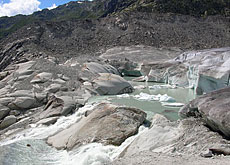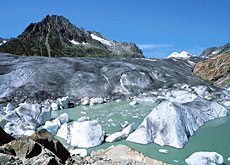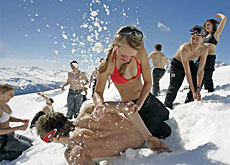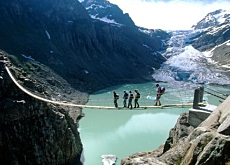Melting glacier could draw tourists

Motorists who stop to admire the magnificent Rhone glacier in canton Valais may soon find an unexpected attraction on offer - boat trips.
Rising temperatures are melting the ice and a lake is forming at the foot of the glacier, right next to the road over the Furka pass. Experts expect it to grow rapidly.
The lake is just one more example of how Swiss glaciers are gradually melting away due to the effects of global warming.
“This lake is unique in the Alps,” Valais tourism director Urs Zenhäusern told swissinfo. The Arctic-type scenery that is developing around the glacier is something special, he said.
No one is glad to see the glaciers shrink, but the new lake opens up new possibilities. Zenhäusern said sightseers could visit the glacier by boat, as they can in Alaska or Canada.
Climate change and disappearing glaciers could even become a tourist attraction in themselves. Glaciers are already drawing more visitors than they used to as it is thought they may not be around for the next generation.
Switzerland has around 1,800 glaciers. Experts say that if the temperature rises by an average of three degrees Celsius, 80 per cent of them will have disappeared by 2100. A rise of five degrees would lead to their total disappearance.
Currently, Swiss glaciers are melting at a rate of three per cent a year.
Consideration is also being given to the construction of a power station at the Rhone glacier lake site. But Zenhäusern is not worried. “Tourism and power generation are not mutually exclusive,” he said.
Danger
Glacier lakes can, however, be treacherous. Boulders and scree can dam the outlet, building up a reservoir of water which may burst out later with lethal consequences. Blocks of ice falling from the glacier can also create dangerous waves.
Experts from the Federal Institute of Technology in Zurich are monitoring developments in order to draw up safety measures.
At the moment the lake is still small. But geologists believe that the glacier is melting so fast that in 10-20 years it could be 1.6km long, 600metres wide and 124m deep.
The Rhone glacier has long been a tourist attraction. But it has retreated dramatically over the past 150 years. Pictures from the middle of the 19th century show the ice reaching into the village of Gletsch in the valley; now it is 2.5km further back and 450m higher.
swissinfo, based on a German article by Corinne Buchser
The Rhone glacier is the fifth longest in Switzerland, but has been shrinking over the past 150 years. Between 1980 and 2006 it retreated by about 200m.
The glacier is the source of the Rhone, which flows through Lake Geneva and enters the Mediterranean at Marseille.
Switzerland has about 1,800 glaciers, almost all of which are retreating.
Experts say that if temperatures rise by an average of three degrees Celsius, 80% of the glaciers will have disappeared by 2100. A rise of five degrees would lead to their total disappearance.
The Alpine glaciers are a major source of water not only in Switzerland but also for the whole of western Europe.
Greenpeace is planning a nude global warming stunt on August 19 recruiting hundreds of volunteers to pose naked on a Swiss glacier to draw attention to climate change. The environmental group has commissioned New York artist Spencer Tunick to take photographs of the event.

In compliance with the JTI standards
More: SWI swissinfo.ch certified by the Journalism Trust Initiative



You can find an overview of ongoing debates with our journalists here . Please join us!
If you want to start a conversation about a topic raised in this article or want to report factual errors, email us at english@swissinfo.ch.